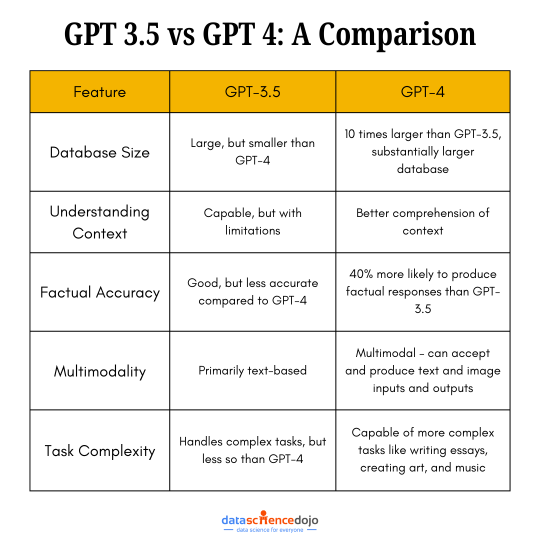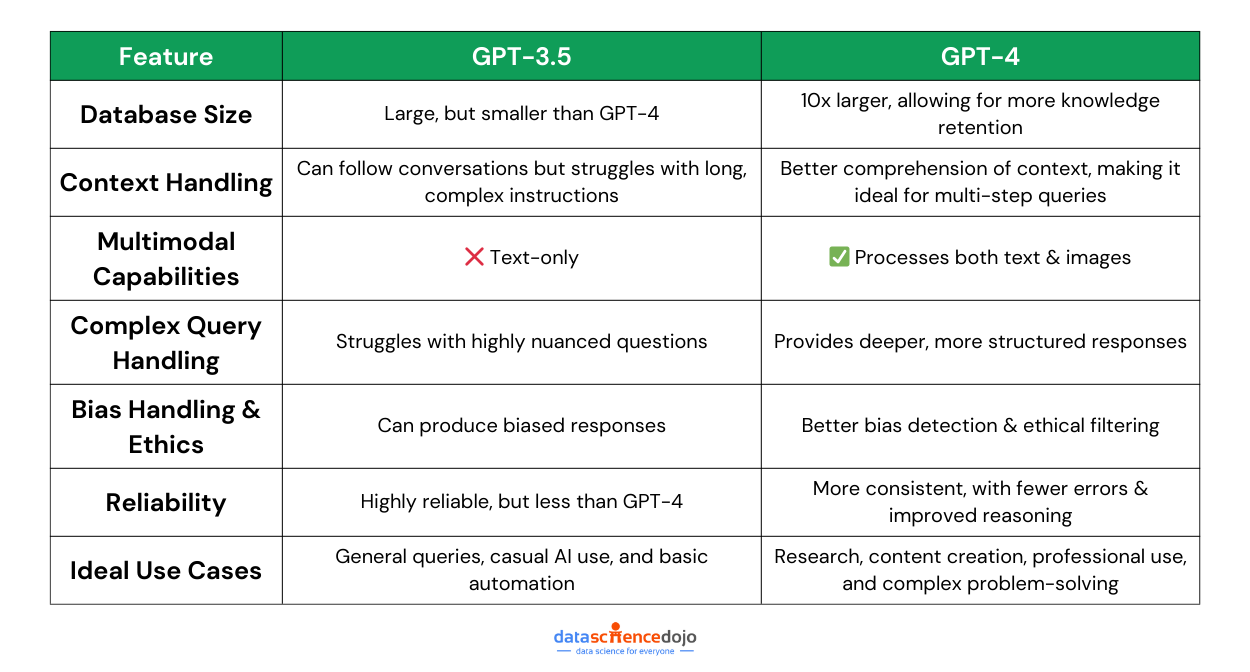In today’s world, artificial intelligence is a useful tool for day-to-day tasks. From crafting an important email and brainstorming content ideas to learning a new language, an AI tool can generate exactly what you need. That’s the power of AI language models like GPT-3.5 and GPT-4, transforming the way we work, communicate, and create.
According to OpenAI, 92% of Fortune 500 companies are leveraging AI-driven tools like ChatGPT to streamline operations and enhance productivity. But with the release of GPT-4, a key question arises: How does it compare to GPT-3.5? Is it just an upgrade, or is it a game-changer?
Let’s dig deeper into the comparative analysis of GPT 3.5 vs GPT 4 and find answers to these questions and more.
What is GPT? Why do we Need It?
GPT stands for Generative Pretrained Transformer, which is a large language model (LLM) chatbot developed by OpenAI. It is a powerful tool that can be used for a variety of tasks, including generating text, translating languages, and writing different kinds of creative content.
Here are some of the reasons why we need GPT:
1. It can help us to communicate more effectively. It can be used to translate languages, summarize text, and generate different creative text formats. For example, a company can use GPT to translate its website and marketing materials into multiple languages in order to reach a wider audience.
2. GPT makes us more productive. It can be used to automate tasks, such as writing emails and reports. For example, a customer service representative can use GPT to generate personalized responses to customer inquiries.
3. It enhances the creativity in our work. It can be used to generate new ideas and concepts. For example, a writer can use GPT to brainstorm ideas for new blog posts or articles.
Hence, GPT-powered AI models are leveraged by businesses worldwide to provide personalized experiences, automate complex tasks, and derive valuable insights from data. Here are some examples of how GPT is being used in the real world:
- Expedia uses GPT to generate personalized travel itineraries for its customers
- Duolingo uses GPT to generate personalized language lessons and exercises for its users
- Askviable uses GPT to analyze customer feedback and identify areas for improvement
These are just a few examples of the many ways that GPT is being used to improve our lives. As GPT continues to develop, we can expect to see even more innovative and transformative applications for this technology. Since we have an idea of the role of GPT, let’s explore the GPT3.5 vs GPT-4.
Learn more about the role of large language models
GPT-3.5 vs GPT-4: A Comparative Analysis
AI language models have come a long way, and with each new version, we see exciting improvements. OpenAI’s GPT-4 builds upon the already impressive GPT -3.5, offering better accuracy, understanding, and creative capabilities. But what exactly makes GPT-4 stand out? Let’s break it down in simple terms.
1. Enhanced Understanding and Generation of Dialects
- GPT-3.5: Already proficient in generating human-like text.
- GPT-4: Takes it a step further with an improved ability to understand and generate different dialects, making it more versatile in handling diverse linguistic nuances.
Imagine you’re chatting with an AI, and you use a specific regional dialect – GPT-4 is much more likely to understand and respond correctly than GPT-3.5. This makes it a game-changer for global communication. This makes GPT-4 particularly useful for businesses and individuals interacting with multilingual or diverse audiences.
2. Multimodal Capabilities
- GPT-3.5: Primarily a text-based tool.
- GPT-4: Introduces the ability to understand images. For instance, when provided with a photo, GPT-4 can describe its contents, adding a new dimension to its functionality.
This is one of the biggest upgrades! While GPT-3.5 could only respond to written input, GPT-4 takes things a step ahead by interpreting images. You can show GPT-4 a picture, graph, or chart, and it can describe, analyze, or explain it. This feature unlocks a whole new world of possibilities.
Read in detail about multimodality in LLMs
3. Improved Performance and Language Comprehension
- GPT-3.5: Known for its excellent performance.
- GPT-4: Shows even better language comprehension skills, making it more effective in understanding and responding to complex queries.
Ever asked an AI model a detailed question and felt like the response was too generic or missed the point? GPT-4 fixes that by offering more precise answers and understanding longer, more complicated prompts.
4. Reliability and Creativity
- GPT-3.5: Highly reliable in generating text-based responses.
- GPT-4: Touted as more reliable and creative, capable of handling nuanced instructions with greater precision.
AI is about more than just question-answering. It is also used for creative writing, coding, and problem-solving. In these uses, GPT-4 is more creative and precise as it can write better stories, generate more logical code, and brainstorm innovative ideas.
5. Data-to-Text Model
- GPT-3.5: A text-to-text model.
- GPT-4: This evolves into a more comprehensive data-to-text model, enabling it to process and respond to a wider range of data inputs.
This makes GPT-4 especially useful for businesses and researchers who need AI to analyze spreadsheets, generate reports, or summarize complex datasets in an easy-to-understand format. For instance, if you provide sales data, GPT-4 can summarize trends and insights rather than just repeating numbers.
Real-World Examples Illustrating the Differences
- Dialect Understanding:
- Example: GPT-4 can more accurately interpret and respond in regional dialects, such as Australian English or Singaporean English, compared to GPT -3.5.
- Image Description:
- Example: When shown a picture of a crowded market, GPT-4 can describe the scene in detail, including the types of stalls and the atmosphere, a task GPT-3.5 cannot perform.
- Complex Query Handling:
- Example: In a scenario where a user asks about the implications of a specific economic policy, GPT-4 provides a more nuanced and comprehensive analysis than GPT -3.5.
To sum up the comparison, you can note that while GPT-3.5 is still a powerful AI model, GPT-4 offers major improvements. GPT-4 offers an enhanced experience in understanding language, handling complex queries, processing images, and generating creative content. The model is a step closer to making AI feel more human-like and intelligent.
Read about: OpenAI Dismisses Sam Altman
Handling Biases: GPT 3.5 vs GPT 4
GPT-4 has been designed to be better at handling biases compared to GPT-3.5. This improvement is achieved through several key advancements:
1. Enhanced Training Data and Algorithms: GPT-4 has been trained on a more extensive and diverse dataset than GPT-3.5. This broader dataset helps reduce biases that may arise from a limited or skewed data sample.
Additionally, the algorithms used in GPT-4 have been refined to better identify and mitigate biases present in the training data.
2. Improved Contextual Understanding: GPT-4 shows advancements in understanding and maintaining context over longer conversations or texts. This enhanced contextual awareness helps in providing more balanced and accurate responses, reducing the likelihood of biased outputs.
You can also learn about GPT-4 Vision here
3. Ethical and Bias Considerations in Development: The development of GPT-4 involved a greater focus on ethical considerations and bias mitigation. This includes research and strategies specifically aimed at understanding and addressing various forms of bias that AI models can exhibit.
4. Feedback and Iterative Improvements: OpenAI has incorporated feedback from GPT-3.5’s usage to make improvements in GPT-4. This includes identifying and addressing specific instances or types of biases observed in GPT-3.5, leading to a more refined model in GPT-4.
5. Advanced Natural Language Understanding: GPT-4’s improved natural language understanding capabilities contribute to more nuanced and accurate interpretations of queries. This advancement helps in reducing misinterpretations and biased responses, especially in complex or sensitive topics.
While GPT-4 represents a significant step forward in handling biases, it’s important to note that completely eliminating bias in AI models is an ongoing challenge. Users should remain aware of the potential for biases and use AI outputs critically, especially in sensitive applications.
Conclusion
The transition from GPT-3.5 to GPT-4 marks a significant leap in the capabilities of language models. GPT-4’s enhanced dialect understanding, multimodal capabilities, and improved performance make it a more powerful tool in various applications, from content creation to complex problem-solving.
As AI continues to evolve, the potential of these models to transform how we interact with technology is immense.







